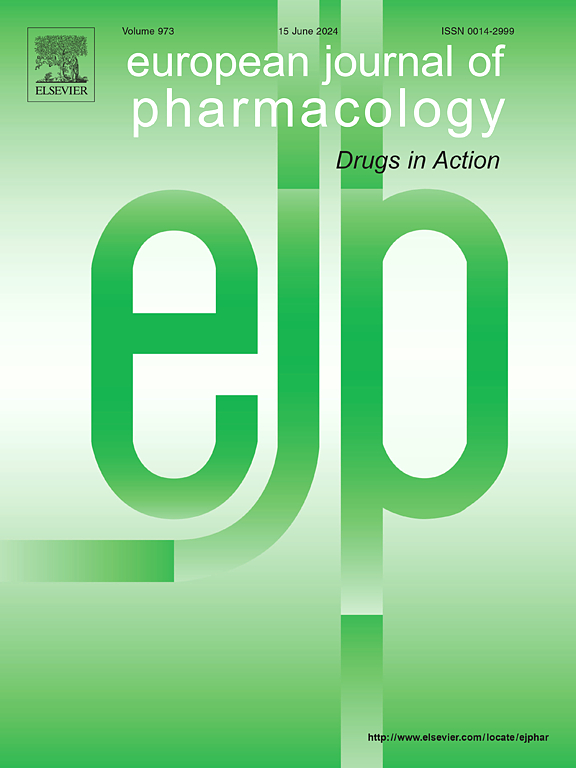治疗性抑制S100A8/A9可降低缺血心肌中NADPH氧化酶的表达、活性氧的产生和NLRP3炎性体的启动。
IF 4.2
3区 医学
Q1 PHARMACOLOGY & PHARMACY
引用次数: 0
摘要
氧化应激和氧化还原信号的改变与心肌梗死(MI)的病理生理有关。NADPH氧化酶(Nox)是梗死心肌活性氧(ROS)的重要来源。Alarmin S100A8/A9可放大心肌梗死急性心肌炎症,已被证明是改善心肌梗死后心功能的有希望的治疗靶点。我们旨在阐明S100A8/A9、氧化应激和心肌梗死炎症反应之间的潜在机制。在C57BL/6J小鼠中,通过永久性左冠状动脉结扎诱导心肌梗死,然后用S100A8/A9抑制剂ABR-238901 (30 mg/kg)或PBS治疗3天。体内实验辅以培养巨噬细胞(Mac)的机制研究,巨噬细胞是心肌梗死的重要细胞效应物。与假手术动物相比,我们检测到心肌梗死小鼠左心室中Nox1、Nox2、Nox4催化亚基mRNA和蛋白质水平的显著增加,nadph依赖性ROS的产生也显著增加。S100A8/A9阻断可阻止Nox1/2/4表达上调,减少ROS形成,抑制NF-kB活化,阻止NLRP3炎性小体的启动和激活,导致活性IL-1β水平降低。在体外实验中,S100A8/A9以tlr4依赖和剂量依赖的方式诱导Mac中Nox催化亚型和NLRP3的基因表达。这些作用被S100A8/9、TLR4、Nox14和Nox2的药理抑制所抵消。综上所述,我们发现S100A8/A9引发的Nox上调和ROS形成有助于梗死心肌NLRP3炎症体的启动和IL-1β的产生。这些机制可以治疗靶向预防急性心肌梗死的炎症性和氧化性心肌损伤。本文章由计算机程序翻译,如有差异,请以英文原文为准。

Therapeutic S100A8/A9 inhibition reduces NADPH oxidase expression, reactive oxygen species production and NLRP3 inflammasome priming in the ischemic myocardium
Oxidative stress and alterations in redox signalling have been implicated in the pathophysiology of myocardial infarction (MI). NADPH oxidase (Nox) is an important source of reactive oxygen species (ROS) in the infarcted myocardium. Alarmin S100A8/A9 amplifies acute myocardial inflammation in MI and has been shown to be a promising therapeutic target to improve cardiac function post-MI. We aimed to elucidate the underlying mechanisms linking S100A8/A9, oxidative stress and the inflammatory response in MI. MI was induced by permanent left coronary artery ligation in C57BL/6J mice, followed by treatment with the S100A8/A9 inhibitor ABR-238901 (30 mg/kg) or PBS for 3 days. The in-vivo experiments were complemented with mechanistic studies on cultured macrophages (Mac), important cellular effectors in MI. Compared to sham-operated animals, we detected significant increases in the Nox1, Nox2, Nox4 catalytic subunits at mRNA and protein levels, and NADPH-dependent ROS production in the left ventricle of MI mice. S100A8/A9 blockade prevented the up-regulation of Nox1/2/4 expression, reduced ROS formation, suppressed NF-kB activation and prevented NLRP3 inflammasome priming and activation, leading to reduced levels of active IL-1β. In-vitro, S100A8/A9 induced gene expression of Nox catalytic subtypes and NLRP3 in Mac in a TLR4-dependent and dose-dependent manner. These effects were counteracted by pharmacological inhibition of S100A8/9, TLR4, Nox1/4 and Nox2. In conclusion, we show that Nox upregulation and ROS formation triggered by S100A8/A9 contributes to NLRP3 inflammasome priming and increased IL-1β production in the infarcted myocardium. These mechanisms can be therapeutically targeted to prevent inflammatory and oxidant myocardial damage in acute MI.
求助全文
通过发布文献求助,成功后即可免费获取论文全文。
去求助
来源期刊
CiteScore
9.00
自引率
0.00%
发文量
572
审稿时长
34 days
期刊介绍:
The European Journal of Pharmacology publishes research papers covering all aspects of experimental pharmacology with focus on the mechanism of action of structurally identified compounds affecting biological systems.
The scope includes:
Behavioural pharmacology
Neuropharmacology and analgesia
Cardiovascular pharmacology
Pulmonary, gastrointestinal and urogenital pharmacology
Endocrine pharmacology
Immunopharmacology and inflammation
Molecular and cellular pharmacology
Regenerative pharmacology
Biologicals and biotherapeutics
Translational pharmacology
Nutriceutical pharmacology.

 求助内容:
求助内容: 应助结果提醒方式:
应助结果提醒方式:


